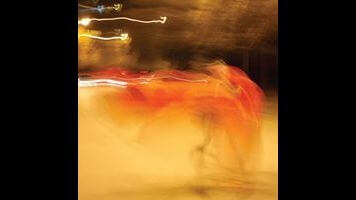William Basinski offers a eulogy for David Bowie (if that’s what you want to believe)

Ambient music, like any form of abstract art, relies on context. In the absence of lyrics—and often rhythm or melody—something has to give form to the formless, a title card explaining that those fuzzy black rectangles are actually Nude Woman Lamenting A Dying Earth. It’s why so many ambient albums, beginning with Brian Eno’s genre-defining Discreet Music, attempt to establish the mind-set with which it should be approached. This can be as didactic as Eno including a diagram of his equipment so you’ll appreciate the mechanics of what you’re hearing, or as impressionistic as a cover photo of blurry trees or stark, Brutalist architecture. It can mean inventing a full-fledged narrative, like The Caretaker’s evocation of nostalgia tattered by dementia, or giving interviews where you invoke some New Age ideal about the need for quiet reflection in a chaotic world. Whatever helps to differentiate your more purposeful, “serious” ambient music from the soporific wallpaper you hear at the health spa.
William Basinski arguably understands context better than anyone in his field. He first started making his tape loop experiments in the late 1970s (informed by Eno’s Discreet Music schematic), then spent decades tinkering with their sobering, staticky sound in underground art spaces, but he didn’t get much attention for them until 2002’s The Disintegration Loops became inextricably intertwined with 9/11. The legend behind The Disintegration Loops’ creation is inseparable from the finished piece: You can certainly enjoy it solely for its meditative, melancholy atmospheres, but it takes on extra dramatic weight knowing that Basinski’s old cassette loops of random Muzak, recorded as they crumbled on his tape deck in real time, completed their final limp toward oblivion just as the Twin Towers were collapsing outside his Brooklyn loft. That connection becomes even more poignant when paired with the album’s cover photo and accompanying video of a smoldering Manhattan skyline. Critics hailed the album as a timely reminder on the fragility—and resilience—of humanity, and today, The Disintegration Loops is regarded as a defining post-9/11 artwork; it’s since been performed by an orchestra at a 10th-anniversary wake and inducted into the National September 11 Memorial & Museum.
Naturally, linking something to tragedy like that invites controversy, and over the years, some have accused Basinski of exploiting 9/11, forcing that connection to fabricate some deeper meaning for—and draw greater attention to—a work that is, however moving, essentially just a collection of found sounds. There’s a similar, if smaller-scale, debate to be had about Basinski’s new A Shadow In Time, which has once again garnered a lot of preemptive press thanks to it being a partial “eulogy” for David Bowie. As with The Disintegration Loops, it’s up to the listener to decide whether that context feels genuine—and your enjoyment may depend on whether you feel the Bowie angle adds or detracts.
Superficially, “For David Robert Jones” bears little relationship to Bowie or his music. In fact, it evokes Bowie far less than it does Basinski himself. Composed of a crackling, circular orchestral riff—repurposed from tape fragments reportedly chewed up by a “big, fat motherfucker” of a cat belonging to Basinski’s roommate—the track resembles the stately decay of The Disintegration Loops more closely than any of his recent releases. It could easily be an outtake or sequel, were it not for the distorted honk of a saxophone that enters a third of the way through its 20-minute runtime, upending the mood.

 Keep scrolling for more great stories from The A.V. Club.
Keep scrolling for more great stories from The A.V. Club.